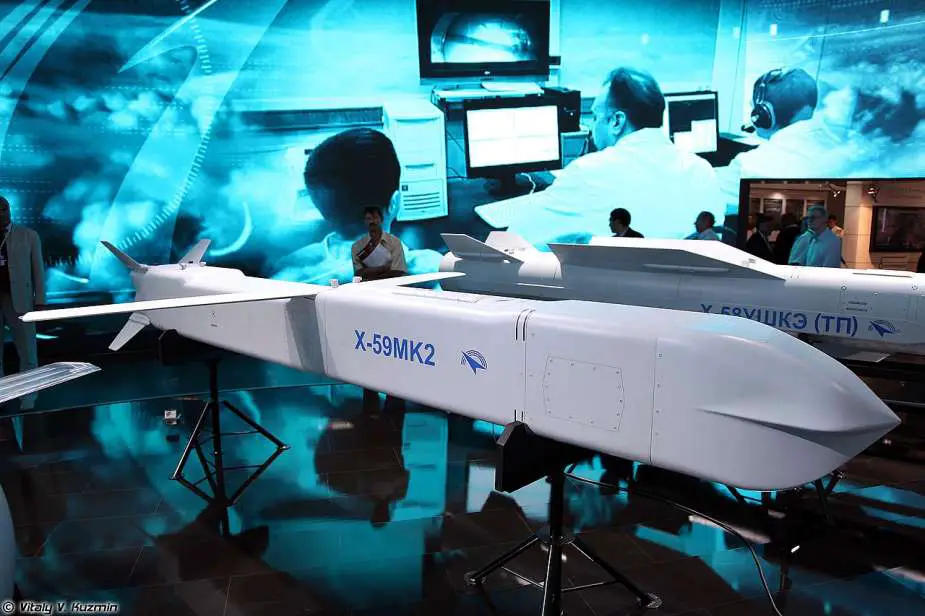On December 30th, Russian forces launched new strikes using the upgraded Kh-59Mk2 cruise missiles on the cities of Odessa and Dnipro. These increasing attacks were executed by tactical aviation operating from the Black Sea. The deployment of the Kh-59Mk2, an upgraded version of the Kh-59 missile, reflects a tangible consequence of Russia's advancing armaments production, demonstrating an escalation in the sophistication and capability of the weaponry being utilized in the conflict.
Follow Army Recognition on Google News at this link

Kh-59MK2 missile is an air-launched cruise missile designed for tactical aviation (Picture source: Vitaly Kuzmin)
Since the beginning of December, Ukraine has been subjected to significant strikes across its entire territory, marked by the use of Russian strategic bombers and various missiles, including the Kh-59 and long-range KH-101 cruise missiles. These attacks also involve using Geran-2 drones, signaling a significant intensification of the Russian offensive.
The Kh-59 missile is an air-launched cruise missile designed for tactical aviation. It can be used on aircraft such as the Su-24M, Su-30, Su-34, Su-35, and Su-57. This missile comes in three basic variants: the Kh-59, Kh-59M, and Kh-59MK2, the latter being available in two subvariants. The launch range of these modifications varies from 45 kilometers to 110 kilometers and can reach up to 285 kilometers.
According to British intelligence, the regions of Chernihiv, Sumy, Kharkiv, Dnipropetrovsk, Zaporizhzhia, and Kherson have been most affected by such weapons.
The Russian forces are likely using the Kh-59MK2 variant for their strikes in Ukraine. This assumption is based not only on its extended launch range but also on its guidance system, which may overcome the limitations of the Kh-59 and Kh-59M variants, known for their sensitivity to fog and rain.
Regarding the specific characteristics of the Kh-59MK2 cruise missile, it has a fuselage length of only 4.2 meters, a wingspan of 2.45 meters, a launch weight of 770 kg, and its warhead can be either penetrative or cassette-type, weighing 310 kg. Interestingly, the Kh-59MK2 missile is equipped with the TRDD-50B engine, a variant of the TRDD-50 engine also used in long-range Russian cruise missiles like the Kh-101 and the 3M-14 Kalibr.
The Kh-59MK2 can only strike stationary ground targets with precise coordinates - it has limited maneuverability. The Kh-59MKM was designed to hit static ground and surface targets. It is equipped with the "SNAU-59MK-02" navigation-automatic control system with satellite correction.
The Kh-59 missile is a small-sized air target, even smaller in fuselage length than the Kh-101 missile (4.2 meters compared to 7.45 meters for the Kh-101). This significantly complicates the task of intercepting Kh-59-type cruise missiles, making each successful interception of such an aerial target a remarkable achievement for the Ukrainian Air Defense Forces.
It should be noted that Russian forces have been using Kh-59 missiles for strikes on Ukrainian civilian infrastructure since the early weeks and months of the large-scale invasion. For instance, as previously reported by Defense Express, by mid-April 2022, there were already two known incidents involving the use of Su-57 aircraft, which had launched Kh-59 missiles at targets in the Odessa Sea Port and the Kirovohrad region. In March 2022, Su-35 jets equipped with Kh-59 missiles were used by the occupiers for strikes on oil depots in the Rivne region, causing significant damage. Additionally, the Su-34 fleet has also regularly fired long-range missiles, such as the Kh-29 and Kh-59, against fixed targets.
Therefore, the destruction of this type of cruise missile remains a priority for Ukrainian forces. It is also worth recalling that on October 1, 2023, there was a successful attack against the Smolensk Aircraft Plant, which is part of the Russian state-owned Tactical Missiles Corporation and is a key subcontractor for missiles used by aviation, including the Kh-59 type.
Another important site for the production of KH-59 is the Raduga factory located in Dubna, near Moscow. This factory, which plays a key role in the development and manufacture of Kh-59 missiles, has seen considerable development in recent decades. Expansion and modernization efforts at this site have been significant, marked by the addition of new production buildings and an overall increase in manufacturing capacity. Additionally, Raduga holds licenses for the production of military hardware and has been involved in Russia's systematic preparations for the current conflict. The Dubna factory has become a crucial element in the production chain of Kh-59 missiles, a tactical cruise missile used by Russian forces in various conflicts, including the current offensive in Ukraine.
The expansion of arms manufacturing facilities appears to be a widespread phenomenon across Russian territory, corroborated by an announcement from the Russian Ministry of Defense in August 2023 regarding a significant increase in the country's arms production. This ramping up of Russian military production likely includes a wide variety of weapons, including advanced missiles such as the Kh-59, reflecting Russia's intent to enhance its offensive capabilities.















